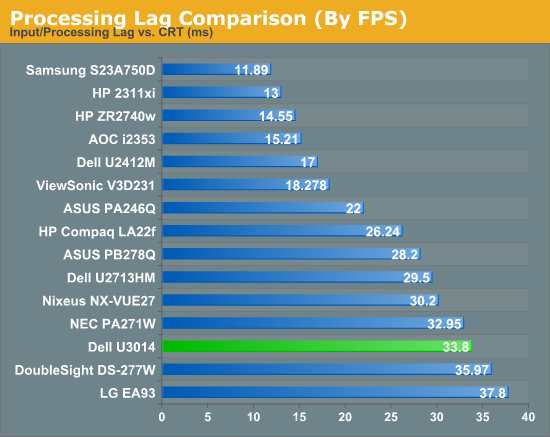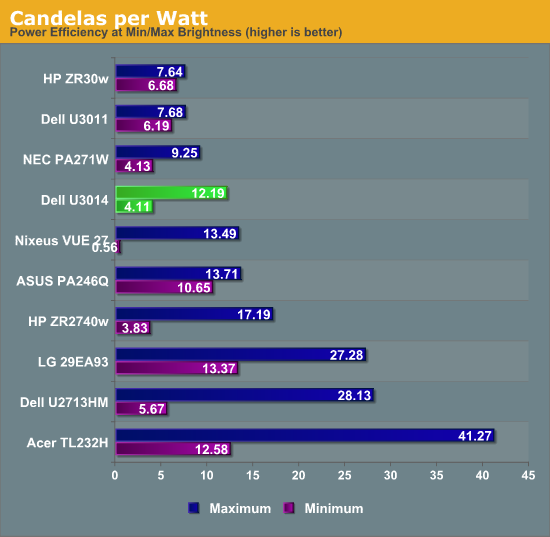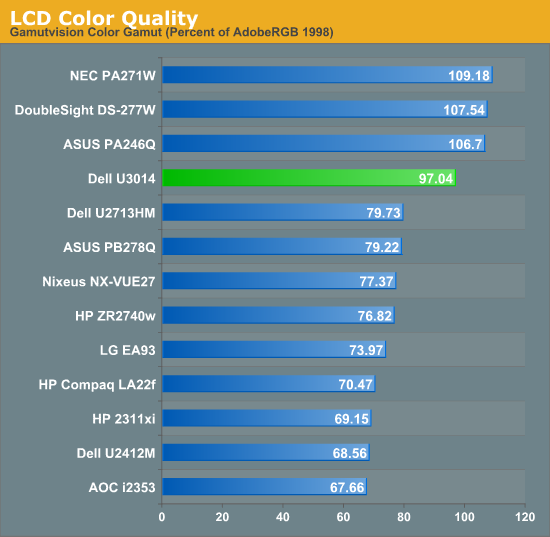Dell U3014 LCD Review
by Chris Heinonen on April 15, 2013 2:00 PM ESTUnfortunately, as I went to test this display using SMTT, which I’ve used for the past year, I found my license has expired. Furthermore, the author has stopped selling licenses right now, so we can’t use it anymore. This is unfortunate as it let us easily determine input lag versus pixel response time, and nothing else does that as well. With that gone, I went to three different options to test the lag on the Dell U3014:
- The Leo Bodnar Lag Tester
- FlatPanelsHD lag timer
- 3DMark03
Using the FlatPanelsHD test, it was a straight 49 or 50ms each time on the U3014. Since you have to mirror this on a CRT, that means running at 1920x1080 resolution on the Dell so the usual caveats apply, though it was the same lag with 1:1 pixel mapping or with scaling, so at least that introduces no additional penalty.
Using 3DMark03, I managed to measure right around 37.3ms, and with the Leo Bodnar lag tester I measured 33.8ms. All of these were while running in Game Mode, so the least input lag that I saw was two frames. Because I don’t live in a vacuum, I also looked at the results that TFT Central managed with the same display, since they have an oscilloscope that I don’t and they found virtually no lag at all. I think the 50ms number is really off, as there are issues with using a Flash timer for measuring lag. The Leo Bodnar actually gives three results, 28.4, 34, and 38.9, depending on if you are high, middle, or low on the screen, and so that low one more closely matches up with the 3DMark one, where the FPS counter is at the bottom.
Because of this, I think the Leo Bodnar average of the three is the most accurate number that I can produce right now. Of course, that is over HDMI and not DisplayPort or DVI, and at 1080p, so the reliability of that number is admittedly low, but there is no better solution available to me to measure it right now. I’d like to produce a better number than that, but sadly I can't at present. Hopefully SMTT will come back, as it produces a much better number with more verifiably accurate data, but right now I’m stuck with this method.

Power Use on the Dell is pretty good, considering the size of the panel. With an all-white screen at full backlight, it uses 77 watts of power. With the same screen and minimum backlight, it uses 33 watts of power. Given that 27” CCFL monitors can use well over 100 watts, to get this out of a 30” LCD is very good and a testament to the GB-LED backlighting system. To put this into a new way of measuring, at maximum backlight the U3014 produces 12.19 Candelas per Watt, and at minimum it produces 4.11 Candelas per Watt. I’ll try to use Candelas/Watt going forward, as it allows for uniform evaluations of power efficiency across all screen sizes. There are only a few monitors in here now, but I will try to go back and add more as I can.


We’ve already looked at Gamut a bit with the AdobeRGB charts, but I’m going to use the Gamutvision chart to see exactly how much of the AdobeRGB gamut is covered. According to its data, we see that 97% of the AdobeRGB gamut is accounted for. The Dell specs call for 99%, but with our slight under-saturation in red that probably accounts for the difference. It is still a very good number overall and should satisfy those that need the expanded gamut of AdobeRGB.












84 Comments
View All Comments
Filiprino - Wednesday, April 17, 2013 - link
Your source of lag must be the use of HDMI.cheinonen - Thursday, April 18, 2013 - link
HDMI and DisplayPort were virtually identical in this regard.red5un - Wednesday, April 17, 2013 - link
How does the new dell stack up against the NEC PA30 color wise? Love your new testing methodology but I wish there was a way to see a direct comparison. Is there a possibility of you guys retesting some of the higher end monitors? Are LED monitors finally ready to do color critical work? We do print and commercial VFX work and the NEC's are great but recalibrating every week plus knowing the CFL's are slowly dying I'm wondering if LED will be the answer.cheinonen - Thursday, April 18, 2013 - link
I have no idea how the NEC 30" would fare, as I only tested the 27", and that was with the older test format. Getting in an older monitor is less likely to happen, if only because manufacturers often don't have review samples of displays that are older laying around anymore. I'll see what possibility exists, though it would more likely just be a quick review with only the test data, and not the in-depth commentary, since that has been covered before.soerenL - Thursday, April 18, 2013 - link
Thanks for enlightening article!New to wide gamut and display profiling, have been reading a bit about it around the net, but would like know if my workflow makes any sense. Asked this in Dell forums also, apologies in advance if this is the wrong place to ask!
My primary objective is to have accurate colors in Maya and Photoshop. Secondary objective is to have accurate colors in games.
I should use sRGB emulation in Maya, and other non color managed applications, and adobeRGB in photoshop and firefox ?
I should profile the display with the provided Dell UltraSharp Color Calibration software, and store a sRGB calibration profile for example in CAL1, and a adobeRGB calibration profile in CAL2. And have the Dell Display Manager switch to CAL2 when using photoshop, and to CAL1 for all applications that aren't color managed ?
i1Profiler (the software that came with the i1Display Pro) can monitor ambient light, and automaticly reprofile based on changes in ambient light. The Dell UltraSharp Color Calibration software doesn't mention measuring ambient light at all, so I don't think the software have that capability ? Is there a way of using the hardware calibration in U3014 and ambient light measurements at the same time ? Would it be ok to install both i1Profiler and the Dell UltraSharp Color Calibration software, at the same time, do first the hardware calibration with the dell software, and then have the i1Profiler build a (software?) profile, that would mostly just reflect changes in ambient light ?
For accurate colors in games (if at all possible) I should use the games preset (to reduce lag) and then use i1Profiler to create a profile ?
sherlockwing - Friday, April 19, 2013 - link
For $1400 Dell should at least consider going up to 2880X1800 for a 16:10 monitor.Zibri - Friday, April 19, 2013 - link
I still think 2010 HP ZR30W is better than this.Oxford Guy - Sunday, April 21, 2013 - link
The u2412m has higher contrast because it's e-IPS. e-IPS has a simpler pixel structure that allows more light to be transmitted. However, e-IPS monitors always come with just 6-bit color and the thin paper used in the u2412m leads to mediocre uniformity.Also, there isn't a single A-MVA panel in your chart which makes your black level/contrast ratio comparison lack adequate perspective. You should include the best and the poorest in your charts, to provide perspective -- especially the best. The best contrast ratio would be from A-MVA.
ZoeAnderson24 - Monday, April 22, 2013 - link
Henry. true that Jean`s comment is terrific... on saturday I got themselves a Mazda after earning $4127 this last four weeks and-a little over, ten-k lass month. without a doubt its the most-financialy rewarding I've had. I started this 6 months ago and right away began to bring home more than $75... p/h. I use this here great link,, All29.comCHECK IT OUTBig Anonymouse - Tuesday, April 23, 2013 - link
Great article!Btw, how come the lag numbers are diametrically opposite to the ones in http://www.tftcentral.co.uk/reviews/dell_u3014.htm review, where it scored with the lowest lag compared to all tested monitors (some of them tested in this article too)? Could you have perhaps resetted the "Game Mode" setting by accident, or something similar?